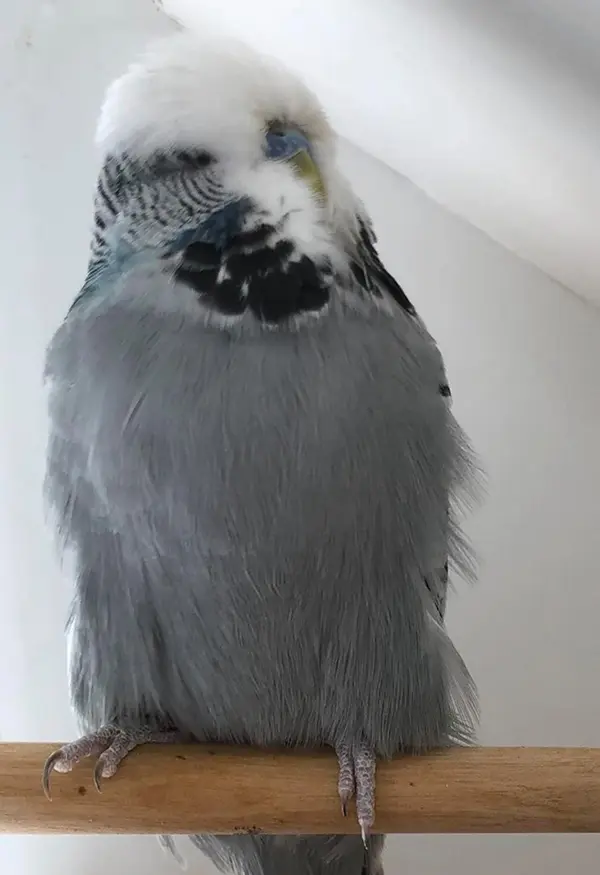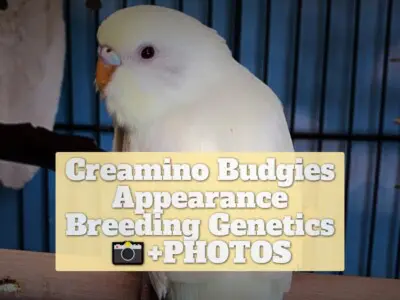Violet budgies are one of the rarest budgies worldwide. Due to the beautiful purple/violet color, many budgie breeders want to have at least one of them.
In short, violet budgies have the same characteristics as normal budgies. Besides the normal budgie’s body colors such as green, gray, and blue, the violet mutation adds an extra purple/violet tint on top of them.
Violet/purple color is possible thanks to the violet factor mutation.
What Is Violet Factor?
The Violet factor is a color-adding mutation that adds a violet tint to the existing body color of the body. Besides, it is semi-dominant to the normal gene.
As a result of the semi-dominant trait, there are two types of violet mutation: single factor violet mutation and double factor violet mutation.
The purple/violet color is fairly hard to produce in budgies. Because the mutation adds a new layer to the existing one. A breeder should choose the right budgie with the right body color that can let the violet factor shows itself clearly.
For example, the violet factor mutation shows itself in blue series budgies more than in green series budgies. It is also hard to identify the violet effects in some blue series and all green series.
What Is Single Factor Violet/purple Budgies?
Single-factor violet budgies have only one violet factor gene that shows itself in the budgie’s body.
Single-factor violet budgies have a lighter violet color added to their existing body color.

What Is Double Factor Violet/purple Budgies?
Double-factor violet budgies have two violet genes that come from both parents.
The violet colors on double-factor budgies are stronger than on single-factor budgies.

How to Identify Violet/Purple Budgies?
It is fairly hard to identify the violet/purple budgies, many times. Although double factor violet budgies are easy to identify, single factor violet budgies are hard to understand.
To identify any violet budgie, it is best to look at the areas where the plumage color of the bird is most intense. These areas are the legs, vent, and rump.
Cobalt blue budgies in the blue series typically show the violet effect better than any other color budgies.
Often, it is difficult to understand a violet budgie when the violet color is weak. In this case, especially the vent and rump area should show more violet effect than any other place on the budgie’s body.
It is almost impossible to understand the violet factor in some green series budgies. For example, a dark green budgie with a violet factor effect may look like an olive green budgie while showing no violet color.
Normal Violet Budgies

Sky-blue Violet Budgies

Mauve Violet Budgies
![Purple/Violet Budgies: Appearance, Breeding, [+PHOTOS]](https://www.petiska.com/wp-content/uploads/2022/07/purple-violet-budgies-appearance-breeding-photos-1656873881.jpg)
Violet Green Budgies

Violet Gray Budgies

Violet Budgies Breeding Outcomes (Punnett Square)
![Purple/Violet Budgies: Appearance, Breeding, [+PHOTOS]](https://www.petiska.com/wp-content/uploads/2022/07/purple-violet-budgies-appearance-breeding-photos-1656917654.jpg)
How Do Breed Violet/purple Budgies?
To breed violet budgies, you need to have a budgie that has at least one violet gene.
Violet/purple Budgie Breeding Expectations Table
| Pairing | Possible Results |
|---|---|
| Single-factor violet/purple + normal budgie | 50% normal, 50% single-factor violet/purple |
| Single-factor violet/purple + single-factor violet/purple | 25% normal budgie, 25% double-factor violet/purple, 50% single-factor violet/purple |
| Double-factor violet/purple + normal budgie | 100% single factor violet/purple |
| Double-factor violet/purple + single-factor violet/purple | 50% single-factor violet/purple, 50% double-factor violet/purple |
| Double-factor violet/purple + double-factor violet/purple | 100% double-factor violet/purple |
Do Purple Budgies Exist in the Wild?
A violet/purple budgie that emerged on its own in nature has not yet been encountered. The purple budgie is not impossible in nature, but it is extremely unlikely.
What Does It Cost to Buy a Purple Budgie?
Purple budgie costs vary worldwide. They have price tags between $10 to $100. In addition, in some cases, a rare budgie may have the violet gene and its price may reach high figures.
Average Life Span & Health Issues
Purple/violet budgies have a lifespan of about 5 to 8 years. This lifespan expectancy depends on many factors including health, diet, and environment.
What Does a Purple Budgie Eat or Drink?
Violet/purple budgies eat and drink the same things as normal budgies. A violet budgie should have a diet that includes 10% protein (insects etc.), 25% greens, fruits, and berries, and 65% seeds (grass seeds, etc.).
Can a Purple Budgie Talk?
Yes, purple budgies can talk without any problems.
How Often Should I Clean My Purple Budgie’s Cage?
You should clean your purple budgie’s cage once a week. This period shouldn’t be exceeded because the unwanted bacteria may populate.
Should I Allow My Purple Budgie to Fly?
Yes, to provide your purple budgie with a healthy skeleton and musculature, you need to let your bird fly.
Should I Get Another Purple Budgie as a Companion?
This depends on whether your budgie is left alone or not. If you are friends with him enough during the day, you don’t need to get a friend. However, if you can only take care of him for an hour or so a day, it may be better to get him a friend.
Purple Budgie Personality
Purple budgies have the same personality as normal budgies. They are chirpy and extremely social creatures. Purple/violet mutation doesn’t change any behavior.
Do Purple Budgies Get Lonely?
Like all budgies, purple budgies may feel lonely from time to time. Especially during the breeding seasons. If you don’t take enough time, they may feel lonely many times. In this kind of situation, it would be good to have another budgie as a companion.
Do Purple Budgies Bite You?
Purple budgies may bite when they are angry as normal budgies in some situations. The fact that the budgie is purple has no effect on aggression.
![Spangle Budgies: Appearance, Breeding, Varieties [+PHOTOS]](https://www.petiska.com/wp-content/uploads/2022/05/spangle-budgies-appearance-breeding-varieties-photos-1653863280-400x300.jpg)
![Lacewing Budgies [Appearance, Breeding, Genetics] +Photos](https://www.petiska.com/wp-content/uploads/2022/06/lacewing-budgies-appearance-breeding-genetics-photos-1654122448-400x300.jpg)

